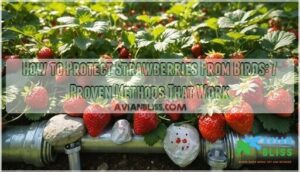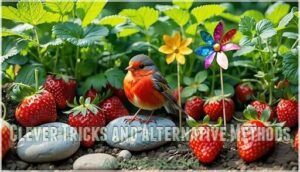This site is supported by our readers. We may earn a commission, at no cost to you, if you purchase through links.
 To protect strawberries from birds, you’ll need to act fast when berries start turning pink, since birds spot that red color like a dinner bell. Cover your plants with ultra-fine mesh netting or build DIY berry cages using PVC pipes and netting. The mesh lets sunlight and rain through while keeping starlings, finches, and blackbirds out.
To protect strawberries from birds, you’ll need to act fast when berries start turning pink, since birds spot that red color like a dinner bell. Cover your plants with ultra-fine mesh netting or build DIY berry cages using PVC pipes and netting. The mesh lets sunlight and rain through while keeping starlings, finches, and blackbirds out.
Add reflective tape, mirrors, or aluminum pie pans around your patch to create light patterns that confuse birds. Harvest berries daily once they’re fully colored, because overripe fruit attracts more feathered visitors.
Some clever gardeners place painted rocks that look like strawberries among plants to fool birds into thinking the good stuff’s already gone. Timing and layered protection make all the difference between a bountiful harvest and bird buffet.
Table Of Contents
- Key Takeaways
- Why Birds Target Strawberry Plants
- Best Physical Barriers for Strawberry Protection
- Visual and Audible Bird Deterrents
- Clever Tricks and Alternative Methods
- Harvesting and Maintaining Healthy Strawberry Crops
- Frequently Asked Questions (FAQs)
- How can I keep birds from eating my strawberries?
- What is the best protection for strawberries?
- How do you protect strawberries from being eaten by animals?
- How do I protect my berry plants from birds?
- How long does a strawberry mesh cover typically last?
- Can birds become immune to visual scare devices?
- Do strawberry varieties differ in bird resistance?
- What time of day are birds most active?
- How do weather conditions affect bird activity?
- How do weather conditions affect bird deterrent effectiveness?
- Conclusion
Key Takeaways
- Install ultra-fine mesh netting before berries turn pink – Cover your plants with quarter-inch mesh that lets sunlight through but keeps birds out, securing all edges to prevent access points.
- Use reflective deterrents around your strawberry patch – Hang Mylar tape, aluminum pie pans, or mirrors near plants to create confusing light patterns that discourage birds from landing.
- Harvest daily once berries reach full color – Pick ripe strawberries immediately since overripe fruit attracts more birds and reduces your overall yield.
- Combine multiple protection methods for best results – Layer physical barriers with visual deterrents and decoy strategies since birds adapt quickly to single protection methods.
Why Birds Target Strawberry Plants
Birds target your strawberry plants because the sweet, juicy berries provide an irresistible high-energy food source, particularly during peak ripening season from late spring through early summer.
You’ll notice that common culprits like robins, sparrows, and starlings can strip entire plants within days, since they’re naturally drawn to the bright red color and sugar content that signals ripe fruit.
Common Bird Species That Eat Strawberries
Your strawberry patch is like a bird buffet that draws in several species ready to wreck your harvest. Robins are the main culprits—they’ll wolf down entire berries in no time. European starlings get pretty aggressive about it, wiping out whole sections of your bed.
House finches and sparrows take a different approach, poking holes in berries and ruining them that way. And blackbirds? Well, ripe strawberries are definitely on their menu.
Several species, including the Cedar Waxwing, are known to feed on strawberries. Understanding these garden pest control challenges helps you select effective strawberry protection methods and bird deterrents for gardens.
What Attracts Birds to Strawberries
Birds zero in on your strawberries because ripening fruit offers irresistible sweetness levels and visual cues that signal peak flavor. The bright red color acts like a dinner bell, while easy access to ground-level berries makes them perfect targets.
When water sources are nearby, birds flock to the area more often.
This means you’ll need solid protection strategies and deterrents to keep them away from your strawberries during growing season.
Signs of Bird Damage in The Garden
You’ll know birds have discovered your strawberry patch when you find partially eaten strawberries with distinctive peck marks and missing fruit entirely. Look for bird droppings near plants, damaged leaves from perching, and seed removal from berry surfaces.
Birds go straight for the sweetest, ripest berries – it’s like they have built-in fruit radar. Once they find your patch, you’ll need solid bird deterrents and protective measures to save your harvest.
Birds have built-in fruit radar for finding the sweetest, ripest strawberries in your garden
Best Physical Barriers for Strawberry Protection
Physical barriers offer the most reliable protection for your strawberry crop, especially when you install them just as the first berries begin to ripen in late spring or early summer. Ultra fine mesh netting, DIY covers, and berry cages create effective shields that keep birds away while allowing sunlight, rain, and beneficial insects to reach your plants.
Using Ultra Fine Garden Mesh Netting
If you’re growing strawberries, ultra fine garden mesh netting is your best bet for keeping birds away. Go with PE material in an 11mm mesh – it lets sunlight and rain reach your plants while keeping those berry thieves out.
When you’re setting it up, make sure to anchor the edges with stakes and give the mesh a quick check now and then for any wear. It’s a smart choice that beats chemical deterrents hands down, plus it won’t break the bank while protecting your harvest.
Building DIY Mesh Covers
Custom frame construction using PVC pipes or wooden stakes creates affordable strawberry garden protection. Choose bird net with quarter-inch openings for effective mesh selection while allowing pollinators through.
Secure all entry points with clips or weights to maintain cover stability. This DIY approach offers enhanced cost analysis compared to commercial berry cage options, letting you tailor bird deterrent methods to your specific strawberry cultivation techniques.
Creating Berry Cages and Cloches
Berry cages offer strong protection when properly constructed with wooden frames and bird net coverage. Choose cage material options like cedar or PVC for durability, incorporating ventilation strategies through mesh panels.
A well-built berry cage really does the job when you frame it with wood and stretch bird netting over the top. Cedar holds up great outdoors, though PVC works too if you’re on a budget. Just make sure you add some mesh panels so air can move through.
You might also try cloches – those little dome covers that sit right over individual plants. The nice thing about them is you can pop the tops off when it’s time to harvest.
Both options keep birds away without needing those reflective tape strips or fake owls scattered around your garden. When winter hits, everything stores away easily until next season.
Visual and Audible Bird Deterrents
You can scare birds away from your strawberry patch using reflective surfaces, sounds, and movement that create an unwelcoming environment. Install shiny Mylar tape, aluminum pie pans, or wind chimes around your berry beds during peak ripening season, usually late spring through early summer, to protect your harvest from persistent feathered thieves.
Setting Up Reflective Surfaces and Mirrors
Reflective materials create effective visual deterrents by confusing birds through light deflection. Strategic mirror placement around your strawberry patch disrupts landing patterns, while surface angles increase bird confusion during peak feeding times.
- Position mirrors at 45-degree angles for best light deflection
- Place reflective materials 2-3 feet above berry plants
- Use multiple small mirrors rather than single large surfaces
- Rotate placement weekly to maintain effectiveness as visual scare device
Using Mylar Tape and Pie Pans
Mylar tape creates vivid flashes when caught by sunlight, making it an effective visual scare device. String strips of metallic Mylar tape between stakes around your strawberry patch, allowing them to flutter and reflect light.
Aluminum pie pans work similarly as bird repellents when hung from branches or posts. These reflective surfaces move with the wind, creating unpredictable light patterns that discourage birds from approaching your berry crops.
Installing Wind Chimes and Playing Distress Calls
Sound-based bird repellents offer effective alternatives to physical barriers. Wind chimes placed within one meter of strawberry beds reduce bird visits by 15% when positioned 1.5 meters high. Distress call effectiveness reaches 50-60% reduction in damage, but bird habituation occurs after two weeks of continuous use. Combining these methods with chemical bird repellents can further deter birds from strawberry crops.
- Chime Placement: Position irregular metal wind chimes randomly around your garden for greatest deterrent effect
- Call Duration: Play species-specific distress calls intermittently every 1-3 hours to prevent bird adaptation
- Sound Frequency: Use timer-controlled devices alternating between wind chimes and recorded alarm calls
- Bird Habituation: Relocate audible scare devices every 2-4 days to maintain effectiveness beyond one month
- Combined Strategy: Pair these auditory deterrents with bird net barriers for thorough protection against persistent species
Clever Tricks and Alternative Methods
When traditional methods aren’t enough, you can outsmart birds with unconventional tactics that catch them off guard during peak strawberry season.
These creative approaches, including decoy strawberries, strategic plantings, and landing deterrents, offer effective alternatives that complement your existing protection strategies.
Decoy Strawberries and Fake Rocks
Decoy strawberry rocks offer clever Avian Control through psychological scare tactics. These fake strawberry rocks fool birds initially, but smart birds quickly learn the trick. Your strawberry garden benefits most when you rotate decoy locations weekly.
Decoy strawberry rocks offer clever bird control through psychological scare tactics. These fake strawberry rocks fool birds at first, but smart birds catch on pretty quickly. Your strawberry garden works best when you move decoy locations around every week.
| Decoy Type | Cost Analysis | Rock Camouflage | Long-Term Use |
|---|---|---|---|
| Painted rocks | $2-5 | High realism | 2-3 weeks |
| Plastic berries | $10-15 | Medium effect | 1-2 weeks |
| Ceramic decoys | $15-25 | Excellent detail | 3-4 weeks |
| DIY alternatives | $1-3 | Variable quality | 1-2 weeks |
These fake berries work best when you use them alongside other garden protection methods. Without moving them around regularly, birds figure out the trick fast and your success rate plummets.
Planting White Strawberries or Flowers
White strawberries offer clever camouflage strategy benefits since birds primarily target red fruit. These white strawberry varieties, like Pineberry, experience considerably less bird damage than traditional plants.
As companion planting for organic gardening strategies, white flowers around strawberry plants create visual deterrents while supporting pollinator attraction. This wildlife management approach reduces crop loss through natural flower choices that confuse foraging birds.
Anti-Landing Gear to Deter Birds
Physical barriers work best when birds can’t land near your strawberries. Strategic placement of spikes and wires around berry cages makes perching uncomfortable.
Physical barriers work best when birds can’t land near your strawberries. Strategic placement of spikes and wires around berry cages makes perching uncomfortable.
Consider these anti-landing solutions:
- Install bird-repellent gel on nearby surfaces to create slippery conditions
- Position rotating deterrents that spin when birds attempt landing
- Use electrified grids around your strawberry patch for wildlife management
When you combine these methods with bird netting, you get solid protection that keeps birds away while leaving your helpful pollinators alone.
Harvesting and Maintaining Healthy Strawberry Crops
You’ll protect your strawberry harvest most effectively by checking plants daily and picking berries as soon as they reach full color, since overripe fruit attracts more birds and reduces your yield.
Maintain consistent watering, remove damaged plants promptly, and coordinate with neighboring gardeners to create a community approach that keeps bird populations moving rather than settling in your area.
Timely Harvesting to Prevent Overripe Fruit
Timing beats everything in strawberry garden warfare against birds. Check your strawberry garden daily during peak season, harvesting fruit when it shows proper ripeness indicators—bright red color with slight give. This harvesting frequency prevents overripe fruit that attracts more wildlife.
Proper storage solutions and processing methods for your harvest reduce waste reduction concerns while maintaining effective wildlife management in gardens.
Allowing Pollinator Access and Hand Pollination
During flowering, you’ll need pollinator-friendly netting that allows bees through while keeping birds out. Choose mesh with 15-25mm openings for attracting pollinators naturally.
Install hand pollination tools like small brushes as backup for timing pollination perfectly.
This sustainable gardening approach aids pollinator diversity while protecting your harvest through organic gardening methods and effective wildlife management in gardens.
Ongoing Garden Maintenance and Community Tips
Keep your strawberry patch thriving with consistent Seasonal Strawberry Care and smart Pest Control Strategies. Check soil moisture weekly, maintain proper Watering Techniques, and monitor for new pest activity.
Join local Community Garden Sharing groups to swap gardening tips about sustainable gardening practices.
Regular Soil Health Management through composting strengthens plants naturally, making wildlife management in gardens easier while supporting your fruit and vegetable gardening success.
Frequently Asked Questions (FAQs)
How can I keep birds from eating my strawberries?
Cover your strawberry plants with fine mesh netting or bird cloth before fruits ripen.
You can also try reflective tape, fake owls, or row covers to deter feathered thieves from your harvest.
What is the best protection for strawberries?
Bird netting offers your strawberries the best shield against feathered fruit thieves. You’ll want to drape fine mesh over your plants before berries ripen, creating an impenetrable fortress that keeps your harvest safe.
Bird netting gives your strawberries solid protection from birds looking for an easy snack.
Put fine mesh over your plants once the berries start forming but before they turn red. This simple barrier keeps most birds away from your crop.
How do you protect strawberries from being eaten by animals?
Use physical barriers like netting or row covers to shield strawberries from rabbits, squirrels, and other animals. Install fencing around beds. Apply repellent sprays regularly for added protection.
How do I protect my berry plants from birds?
Netting works best – drape fine mesh over your berry bushes, securing edges to the ground. Reflective tape, old CDs, or aluminum pans also deter birds effectively through movement and light.
How long does a strawberry mesh cover typically last?
Like your garden’s trusty shovel, quality strawberry mesh covers weather the seasons for multiple years. Most UV-stabilized netting lasts 4-6 years outdoors, with premium materials reaching 7+ years with proper care.
Can birds become immune to visual scare devices?
Yes, birds adapt to visual deterrents over time. They’ll learn that shiny objects and reflective tape aren’t actual threats.
Rotate different scare devices weekly and combine them with other protection methods for better results.
Do strawberry varieties differ in bird resistance?
While some berries shine like rubies, others blend like shadows. Certain strawberry varieties naturally resist bird attention better than others.
Some strawberry varieties naturally get less attention from birds than others. White and yellow varieties work especially well since birds are drawn to that bright red color – without it, your berries might just get passed over.
What time of day are birds most active?
Birds are most active during early morning hours and late afternoon, usually around dawn and dusk.
You’ll notice increased activity as they search for food during these cooler periods of the day.
How do weather conditions affect bird activity?
Weather acts like nature’s conductor, orchestrating bird behavior throughout the day. You’ll notice birds stay sheltered during storms, heavy rain, or extreme cold.
Weather shapes how birds move through their day. When storms roll in or temperatures drop, you’ll find them tucked away in whatever shelter they can find.
But give them calm skies and mild temps? That’s when they come alive, hopping around and hunting for food.
How do weather conditions affect bird deterrent effectiveness?
Strong winds reduce visual deterrent effectiveness, while rain dampens reflective surfaces.
You’ll find calm, sunny days work best for Mylar tape and spinning devices.
Adjust your protection strategy based on forecast conditions for best results.
Conclusion
Successfully protecting your strawberry harvest from feathered thieves requires combining multiple strategies rather than relying on a single method. Physical barriers like ultra-fine mesh netting provide the most reliable defense, while reflective deterrents and decoy strawberries add extra layers of protection.
Timing is everything—start implementing these bird protection measures the moment your berries show the first hint of pink coloring. Regular daily harvesting prevents overripe fruit from attracting more birds to your garden.
With these proven techniques for how to protect strawberries from birds, you’ll enjoy a bountiful harvest instead of feeding the neighborhood wildlife.
- https://en.wikipedia.org/wiki/Latin
- https://sq.wiktionary.org/wiki/mbroj
- https://docs.google.com/forms/d/1GAQr3Kn1cURCVHUA82hAga1Wv8DCH0IuqDLRUrOpN7M/viewform?ts=63f4f653&entry.1515682415=https://www.merriam-webster.com/thesaurus%2Fprotect
- https://premium.britannica.com/mw-unabridged/?utm_source=mw&utm_medium=inline-def&utm_campaign=evergreen
- https://strawberryplants.org/avoid-birds-bugs-pests/










